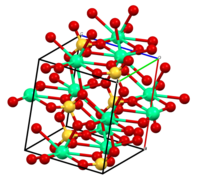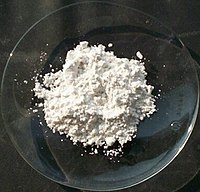Calcium sulphate
 |
|
 |
|
| Names | |
|---|---|
| Other names | |
| Identifiers | |
|
|
|
3D model (Jmol)
|
|
| ChEBI | |
| ChemSpider | |
| ECHA InfoCard | 100.029.000 |
| E number | E516 (acidity regulators, ...) |
| KEGG | |
|
PubChem CID
|
|
| RTECS number | WS6920000 |
| UNII | |
|
|
|
|
| Properties | |
| CaSO4 | |
| Molar mass | 136.14 g/mol (anhydrous) 145.15 g/mol (hemihydrate) 172.172 g/mol (dihydrate) |
| Appearance | white solid |
| Odor | odorless |
| Density | 2.96 g/cm3 (anhydrous) 2.32 g/cm3 (dihydrate) |
| Melting point | 1,460 °C (2,660 °F; 1,730 K) (anhydrous) |
| 0.21g/100ml at 20 °C (anhydrous) 0.24 g/100ml at 20 °C (dihydrate) |
|
|
Solubility product (Ksp)
|
4.93 × 10−5 mol2L−2 (anhydrous) 3.14 × 10−5 (dihydrate) |
| Solubility in glycerol | slightly soluble (dihydrate) |
| Acidity (pKa) | 10.4 (anhydrous) 7.3 (dihydrate) |
| -49.7·10−6 cm3/mol | |
| Structure | |
| orthorhombic | |
| Thermochemistry | |
|
Std molar
entropy (S |
107 J·mol−1·K−1 |
|
Std enthalpy of
formation (ΔfH |
-1433 kJ/mol |
| Hazards | |
| Safety data sheet |
See: data page ICSC 1589 |
| NFPA 704 | |
| Flash point | Non-flammable |
| US health exposure limits (NIOSH): | |
|
PEL (Permissible)
|
TWA 15 mg/m3 (total) TWA 5 mg/m3 (resp) [for anhydrous form only] |
|
REL (Recommended)
|
TWA 10 mg/m3 (total) TWA 5 mg/m3 (resp) [anhydrous only] |
|
IDLH (Immediate danger)
|
N.D. |
| Related compounds | |
|
Other cations
|
Magnesium sulfate Strontium sulfate Barium sulfate |
|
Related desiccants
|
Calcium chloride Magnesium sulfate |
|
Related compounds
|
Plaster of Paris Gypsum |
| Supplementary data page | |
|
Refractive index (n), Dielectric constant (εr), etc. |
|
|
Thermodynamic
data |
Phase behaviour solid–liquid–gas |
| UV, IR, NMR, MS | |
|
Except where otherwise noted, data are given for materials in their standard state (at 25 °C [77 °F], 100 kPa).
|
|
|
|
|
| Infobox references | |
Calcium sulfate (or calcium sulphate) is the inorganic compound with the formula CaSO4 and related hydrates. In the form of γ-anhydrite (the anhydrous form), it is used as a desiccant. One particular hydrate is better known as plaster of Paris, and another occurs naturally as the mineral gypsum. It has many uses in industry. All forms are white solids that are poorly soluble in water. Calcium sulfate causes permanent hardness in water.
The compound exists in three levels of hydration:
The main use of calcium sulfate is to produce Plaster of Paris and stucco. These applications exploit the fact that calcium sulfate which has been powdered and calcined forms a moldable paste upon hydration and hardens as crystalline calcium sulfate dihydrate. It is also convenient that calcium sulfate is very poorly soluble in water; calcium sulfate structures do not dissolve after solidification in dihydrate form.
With judicious heating, gypsum converts to the partially dehydrated mineral called calcium sulfate hemihydrate, calcined gypsum, and plaster of Paris.This material has the formula CaSO4·(nH2O), where 0.5 ≤ n ≤ 0.8. Temperatures between 100 °C and 150 °C (302 °F) are required to drive off the water within its structure. The details of the temperature and time depend on ambient humidity. Temperatures as high as 170 °C are used in industrial calcination, but at these temperatures γ-anhydrite begins to form. The heat energy delivered to the gypsum at this time (the heat of hydration) tends to go into driving off water (as water vapor) rather than increasing the temperature of the mineral, which rises slowly until the water is gone, then increases more rapidly. The equation for the partial dehydration is:
The endothermic property of this reaction is relevant to the performance of drywall, conferring fire resistance to residential and other structures. In a fire, the structure behind a sheet of drywall will remain relatively cool as water is lost from the gypsum, thus preventing (or substantially retarding) damage to the framing (through combustion of wood members or loss of strength of steel at high temperatures) and consequent structural collapse. But at higher temperatures, calcium sulfate will release oxygen and act as an oxidizing agent. This property is used in aluminothermy. In contrast to most minerals, which when rehydrated simply form liquid or semi-liquid pastes, or remain powdery, calcined gypsum has an unusual property: when mixed with water at normal (ambient) temperatures, it quickly reverts chemically to the preferred dihydrate form, while physically "setting" to form a rigid and relatively strong gypsum crystal lattice:
...
Wikipedia

